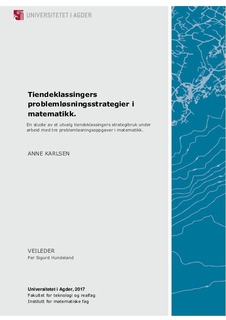| dc.description.abstract | In this study I have looked at a sample of tenth graders and the types of strategies they apply while attempting to solve three problem solving tasks in mathematics. According to the national Norwegian mathematics curriculum, students are supposed to be able to apply problem solving strategies flexibly and efficiently by the time they finish grade 10. My impression is that mathematics teachers in general tend to put more emphasis on other goals and learning outcomes, the ones that will be tested in particular. With that as a backdrop, I wanted to investigate how students undertake different kinds of problem solving tasks; that is tasks that the students do not immediately know how to solve by the use of an algorithm or a formula.
My review of previous research related to problem solving led me to multiple studies that investigated the connection between problem solving performance and self-efficacy. Self-efficacy has to do with how people assess their ability to perform certain tasks. Ultimately these kinds of assessments have the power to influence people’s performance, motivation and stamina. When it comes to mathematical problem solving, researchers have found correlations between students’ self-efficacy beliefs and their problem solving abilities. Students that report to having a higher level of self-efficacy have been found to outperform their less confident counterparts in several areas, mathematical problem solving being one of them.
I wanted to have a look at two research questions, of which the first is: What kinds of strategies do a sample of tenth graders apply while working on three problem solving tasks in mathematics? In order to gain insight into this question, I built a framework that consists of nine categories in order to use it as a basis for my analysis. The framework was inspired by literature from research and other kinds of literature related to mathematical problem solving. I also decided on three problem solving tasks that I wanted to use in my data collection, and I tried to reflect on the types of strategies that would be reasonable to expect on the basis of those tasks.
My second research question is: What kind of connection is there between students’ self-efficacy beliefs regarding problem solving tasks and the strategies they apply while working on solving these? Based on my literature review I initially hypothesized that students with a high level of self-efficacy would be better at purposefully choosing strategies while attempting to solve the three tasks. I tried to measure the students’ levels of self-efficacy by having them fill out a self-assessment form. They were asked to rate their own problem solving abilities, the level of difficulty they perceived in each of the three tasks, and their level of confidence with regards to actually solving the tasks. I created the form after having looked at other studies that had attempted to measure self-efficacy.
In my data collection, I gathered data in the form of video recordings and audio recordings from three sequences of approximately 30 minutes each, where two tenth graders at a time were asked to fill out the self-assessment forms, then collaborate to try and solve the three tasks at hand and eventually took part in an interview where I asked them a few questions. My analysis is based mainly on the video recordings, the students’ notes, and written transcripts of everything that was said during the three sessions. I have attempted to understand and categorize my observations in the nine pre-made categories from my framework as far as possible. The students’ utterances and pictures of their notes are included in the analysis whenever I find that these can shed some light on how the students think and strategize.
5
After having studied and tried to categorize my observations, I was left with utterances or notes that I thought fit into all of my nine categories. The way I see it, some kinds of strategies occur quite frequently, while others rarely occur. There can be several reasons for this distribution, but I think that the three problem solving tasks that I chose play a major role. Aspects that have to do with the students, their mathematical knowledge, previous experiences and characteristics probably also influence their application of strategies.
I was not able to find an answer to my second research question until my analysis and conclusion for my first research question was close to finished. I relied on a final categorization of each student’s strategy use in order to compare it with their self-assessment. Based on my limited data, I was not able to find any kinds of connections between students’ self-efficacy beliefs and their application of strategies. Neither do my findings support my initial hypothesis that students that report to having higher self-efficacy beliefs would be more efficient and accurate in their application of strategies while working on the three problem solving tasks.
Even though learning about problem solving strategies can be beneficial, researchers seem to agree that the best way to enhance problem solving abilities is by gaining experience through practice. This kind of experience is accumulated through attempts at solving many different kinds of mathematical problems.
Research in mathematics education rarely takes leaps forward, for the most part it moves forward by taking little steps at a time. My contribution can hopefully play a part when it comes to inspiring teachers to facilitate more opportunities for problem solving in mathematics. | nb_NO |

